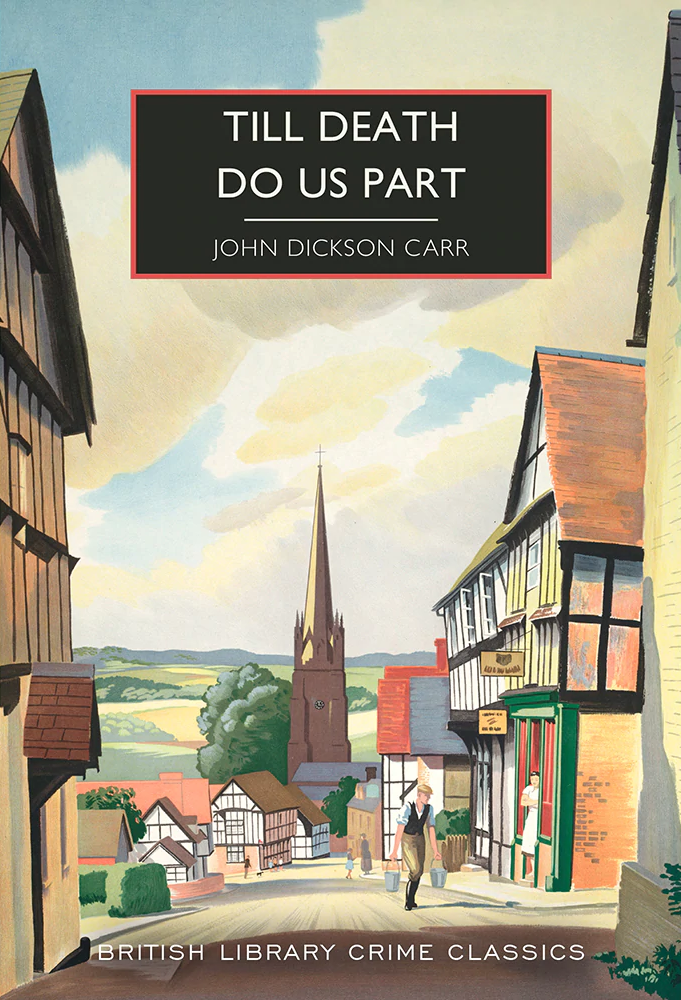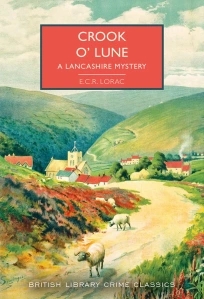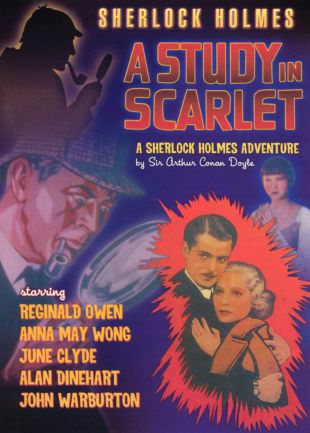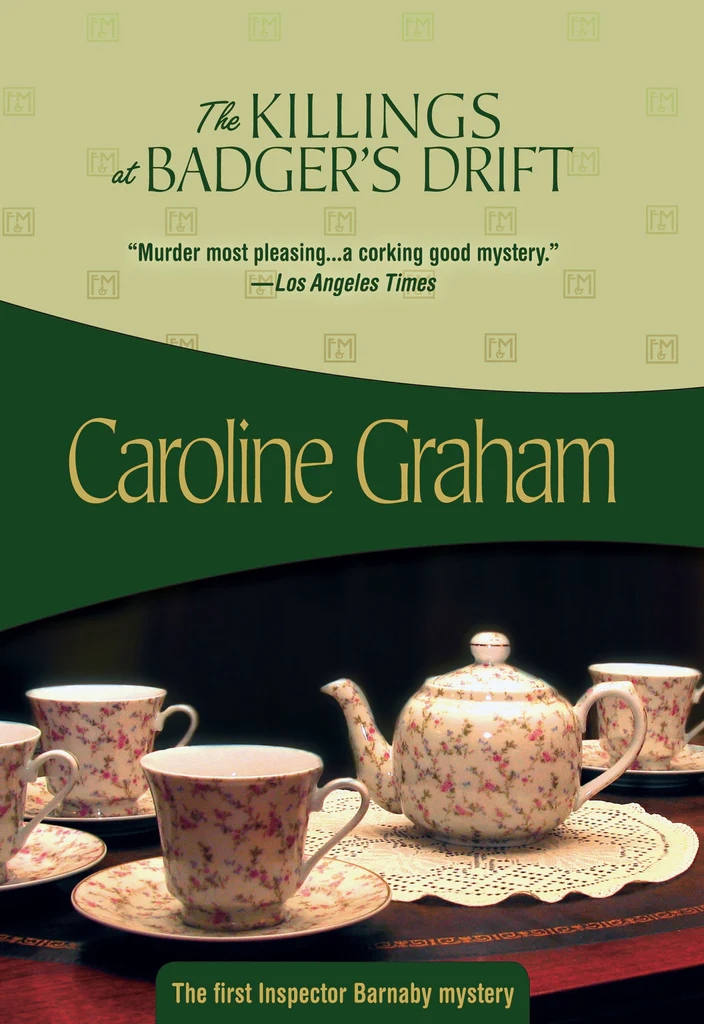
Originally published in 1944
Dr. Gideon Fell #15
Preceded by Death Turns the Tables
Followed by He Who Whispers
Crime author Dick Markham is in love again; his fiancée the mysterious newcomer to the village, Lesley Grant. When Grant accidentally shoots the fortune teller through the side of his tent at the local fair – following a very strange reaction to his predictions – Markham is reluctantly brought into a scheme to expose his betrothed as a suspected serial husband poisoner.
That night the enigmatic fortune teller – and chief accuser – is found dead in an impossible locked-room setup, casting suspicion onto Grant and striking doubt into the heart of her lover. Lured by the scent of the impossible case, Dr. Gideon Fell arrives from London to examine the perplexing evidence and match wits with a meticulous killer at large.
In my four years of crime fiction blogging, I cannot recall being as excited about a vintage crime reprint as I was when I heard that Till Death Do Us Part would be reissued as part of the British Library Crime Classics range. I had previously enjoyed the story in the form of the very faithful BBC Radio adaptation starring Donald Sinden but I was looking forward to getting to read the story properly for myself. Little wonder then that when the package arrived on my doorstep last weekend I immediately put everything else to one side and read it cover-to-cover in a single sitting.
Crime writer Dick Markham arrives at a village fête with Lesley Grant, a woman who has only lived in the area for a matter of months. We learn that the couple have just become engaged and are planning to share the good news later that day. Before they do however they decide they will enjoy some of the attractions and they head to the fortune teller’s booth where a man billed as The Great Swami promises to tell their fortunes.
Lesley enters the tent while Dick chats to the Major who is operating the shooting range next to it. He shares his good news but is surprised when Lesley emerges from the tent looking upset. Dick heads inside to speak to the Swami but before he can learn anything a gunshot is fired through the canvas. He emerges to find Lesley asserting that the rifle, which she had not wanted to hold, had fired by accident. It all seems pretty suspicious, particularly when he receives a telephone call from the doctor asking him to visit his patient who has some information to share with him about his bride to be…
This is a really intriguing setup because of the way it plays around with information. There is the information about Dick’s engagement which we learn may be distressing to at least one other inhabitant of the village, then there’s the information about the Swami’s identity and then there’s the information he has about Lesley. These opening pages are packed with revelations, each serving to shift our understanding of the situation and what is happening long before the murder even takes place. I love the sense of discovery in these early chapters and would suggest that the best way to enjoy this story is to just throw yourself straight into it and be surprised.
The murder comes pretty early in this one and does present an impossibility of sorts, though I do not want to overplay this element of the story. While it’s certainly there and does involve some well-clued details, I think what makes this a compelling story is not so much the mechanics of the crime as the tensions and suspicions it brings about in the various characters.
The story follows Dick’s perspective and so we experience his growing doubts and worries about Lesley as he battles with things he comes to learn and suspect. Carr does this well, incorporating some elements of domestic suspense into the story as Dick grapples with whether he can trust Lesley, how his feelings for her might be affected by what he is told and how he should interact with her moving forwards.
The decision to closely follow Dick means that we are kept at a slight distance not only from Lesley but also from Dr. Gideon Fell who enters the story shortly after the body is found though he is talked about several times prior to that. This is an effective technique as it serves to remind us of Fell’s reputation as a genius for solving impossible crimes, heightening our anticipation for the moment of his arrival. Even once he does appear our focus remains on Dick with some of Fell’s ideas and deductions being kept under wraps until near the end when he swoops in to bring about a resolution. Still, while Fell is utilized in a more limited way than some other of his stories I find him utterly engaging whenever he does appear and would consider this one of his best outings that I have read to date.
One aspect of the novel that I think is very striking is its depiction of life within the confines of an English village. There is of course the depiction of a village festival with their sometimes quite clunky stalls and games as well as the idea that someone might be a bigger celebrity in a small village than they would be in a more urban area hence all of the attention that the villagers pay to Dick. This also feeds into some aspects of the case and in some of the tensions surrounding Dick’s relationship with Lesley. After all the village is a small place and people will gossip, adding pressure to an already tricky situation.
The solution, when it is presented, is a clever one though I admit to finding a few of the crucial details a little tricky to visualize at first. Some aspects of this though are very clever, particularly those relating to what is observed around the time that the gunshot is fired. While Carr has been more ingenious, I do appreciate how the story comes together overall.
What I think seals its status for me as one of the best I have read to date is the manner of the resolution. This is not just an exciting scene which follows a little burst of action, I feel that the construction of this sequence is exceptional and makes very good use once again of the distance between Dick and Fell, building up to a really powerful conclusion that provides some solid closure.
Overall then I have to unimaginatively concur with those voices who suggest that this is one of the best Dr. Fell mysteries. While I wish I had something a little more creative to say about it, all I can really offer is my belief that this holds together really well and that it was a joy to experience again even knowing the solution. This is about as highly recommended as they come.
The Verdict: One of the best Carrs I have read to date, this is every bit as good as its reputation offering a scenario full of twists and turns and a very satisfying conclusion. Highly recommended.




Leave a reply to Aidan Cancel reply